Week 8 - Politics of Diversity
1/39
There's no tags or description
Looks like no tags are added yet.
Name | Mastery | Learn | Test | Matching | Spaced |
|---|
No study sessions yet.
40 Terms
Outline of today: The Politics of diversity
• 1. Why diversity matters for politics
• What happens to social trust, cooperation, and public life as societies become more diverse?
• Competing theories: threat, contact, and constrict
• 2. Diversity and collective action
• How does diversity affect people's willingness to contribute to shared public goods?
• Mechanisms of cooperation: preferences, communication, and coordination
• 3. Diversity and community life
• When does diversity erode trust, and when can bridging social ties offset it?
• The role of everyday interaction and neighbour contact
• 4. Perceiving diversity
• Beyond demographics: how subjective perceptions of one's surroundings shape cohesion
• The idea of "pseudoenvironments" and why perception may matter more than reality
Dinesen, Schaeffer, and Sønderskov (ARPS 2020) -- Research Question
Does ethnic diversity erode social trust on average? Under what conditions are effects strongest or weakest?
Dinesen et al. - Brief Overview (Theories, Observed Variation and Meta Analysis)
• Theories: threat/conflict, contact, and constrict perspectives yield competing predictions for trust
• Observed variation: effects differ by scale (neighbourhood vs nation), trust type (neighbour vs generalized), and covariates
• Meta-analysis integrates disparate results and tests moderators across a large evidence base
Dinesen et al. -- Theory
• Group threat / conflict: diversity increases perceived competition and threat
• Contact: diversity can build positive intergroup contact under the right conditions
• Constrict: diversity leads people to hunker down and withdraw socially
• Implication: competing predictions for how diversity affects social trust
Dinesen et al. -- Theory - Group Threat / Conflict Theory
Definition: As out-group presence rises, in-group members perceive competition over material or symbolic resources.
• Canonical references: Blumer 1958; Blalock 1967; realistic conflict approaches.
• Mechanism: Perceived competition and status threat ⇒ defensive in-group orientation and mistrust of out-group members.
• Empirical implication: predicts lower out-group trust as local diversity rises; may predict higher in-group trust (us--vs--them) and lower willingness to support cross-group public goods.
Dinesen et al. -- Theory - Contact Theory
Definition: Positive, repeated interaction across groups can reduce prejudice and improve mutual understanding
• Canonical reference: Allport 1954 (contact hypothesis)
• Mechanism: Under facilitating conditions (equal status, common goals, cooperative tasks, institutional support), contact weakens stereotypes and anxiety, increasing willingness to trust out-groups
• Empirical implication: predicts higher out-group trust where meaningful intergroup contact is frequent; can raise neighbourhood trust in diverse areas if everyday contact is positive
Dinesen et al. -- Theory - Constrict Theory
• Definition: Diversity reduces social engagement generally; residents hunker down and withdraw from civic life
• Canonical reference: Putnam 2007
• Mechanism: Heterogeneity ⇒ lower informal interaction and weaker local networks ⇒ fewer opportunities to learn about or sanction others, undermining trust broadly
• Empirical implication: predicts lower trust across the board (neighbour, generalized, possibly even in-group) as diversity rises, especially at local scales
Dinesen et al. -- Data
• Narrative review + meta-analysis of 87 studies (1000+ estimates).
• Trust measures: generalized, neighbour, in-group, out-group.
• Diversity measured locally and nationally; partial correlations harmonized.
Dinesen et al. -- Main Findings
• Small but statistically significant negative association between diversity and trust overall.
• Stronger negative effects for neighbour trust and when diversity is measured locally.
• Effects persist with common controls; contact and SES adjustments modestly attenuate, do not eliminate.

Habyarimana et al. (APSR 2007) -- Research Question
• Why does ethnic diversity undermine public goods provision? Which mechanisms explain cooperation shortfalls in heterogeneous groups?
Habyarimana et al. -- Mechanism Families Explained
• Preferences: People may simply prefer to help those like themselves
• Example: A resident might donate more to a community project if they think most beneficiaries share their language or religion
• Prediction: In-group favouritism reduces cooperation across ethnic lines, lowering overall public goods provision
• Technology: Co-ethnics can communicate and sanction one another more easily through shared networks
• Example: A neighborhood group speaking the same language can coordinate trash collection better, and gossip enforces norms
• Prediction: Dense co-ethnic ties make sanctioning effective, boosting cooperation within homogeneous groups
• Strategy Selection: People cooperate when they expect others will too; ethnicity can act as a cue for those expectations
• Example: In a community meeting, individuals may trust co-ethnics to contribute, coordinating on a cooperative outcome, while mixed groups fail to align
• Prediction: Co-ethnics more often reach cooperative equilibria; mixed groups struggle due to uncertainty or mistrust
Habyarimana et al. -- Data
• Kampala, Uganda; approx 300 adult residents from a dense, multi-ethnic urban neighbourhood.
• Behavioural games: dictator/helping tasks (preferences), public goods and coordination games, punishment/sanctioning scenarios.
• Pairings: co-ethnic vs mixed; anonymity vs identifiability; repeated interactions.
Habyarimana et al. -- Ideas
• The study compares how people work together in different game situations to see why ethnic diversity makes cooperation harder
• If it's about preferences: People should give more to others from their own group even when choices are anonymous
• If it's about communication or enforcement: Cooperation should increase when people know each other or can punish free-riders
• If it's about coordination: People from the same group may simply find it easier to trust each other and choose the same cooperative option
• The experiment lets the authors see which of these explanations best fits the patterns of cooperation they observe
Habyarimana et al. -- Main Findings
• No support for preference-based in-group altruism in anonymous settings
• Strong support for strategy selection: co-ethnics coordinate on cooperative equilibria more readily
• Strong support for sanctioning technology: dense co-ethnic networks enable enforcement, sustaining cooperation
• Communication alone isn't enough; network enforcement and expectations matter most
Stolle, Soroka, and Johnston (PS 2008) -- Research Question
• When and for whom does neighbourhood ethnic diversity reduce social trust? Does frequent neighbour interaction mediate or moderate the diversity-trust relationship?
Stolle et al. -- Literature Review
• Prior findings: diversity often linked to lower trust (constrict argument), but effects vary by context and individual experience
• Bridging vs bonding: frequent cross-group contact may buffer negative effects of diversity (contact perspective) • Hypothesis: diversity is most corrosive where local social ties are weak; where neighbour interaction is high, trust levels remain stable even in diverse areas
Stolle et al. -- Data
• Two comparable surveys: US CID and Canadian ESC
• Trust measured via standard generalized-trust questions; local diversity via census data (small-area level)
• Key moderator: frequency of talking with neighbours (local social ties)
Stolle et al. -- Main Findings
• Average effect: more neighbourhood diversity is associated with lower trust among majority respondents
• Conditionality: the negative diversity effect is concentrated among those with low neighbour interaction
• With frequent neighbour talk, diversity's effect on trust lessens or disappears; bridging ties reduce diversity's downsides
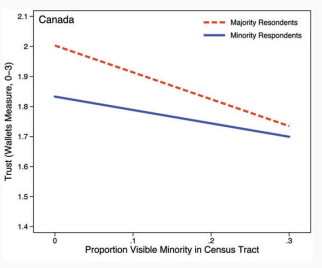


Wong et al (BJPOLS 2025) The politics of place and the politics of diversity
Two ongoing and longstanding debates in Canadian politics
1. The role of geography in politics
2. The effect of diversity on politics
The politics of place
Political geography has a long standing tradition in Canadian political science
• Provincial and regional politics (Gibbins, 1980; Simeon & Elkins, 1974; Gidengil et al, 1999; Wiseman, 2007)
• Urban-rural, urban-suburban etc divides (Walks, 2005; Cutler & Jenkins; Armstrong et al, 2022; McGrane et al, 2017)
• Various other aggregations of geography (Carty & Eagles, 2005; Cochrane & Parella 2012; Gidengil, 1999; Henderson, 2004)
• Loewen & Rubenson on the "local parliament"
• Canadian nation building has by necessity been about the geography of the country
• The politics of federalism itself is in some ways the politics of geography
• You do not need to know or remember the literature here, just note the ideas!
The Politics of Diversity
Canadian politics is to some extent also the politics of diversity
• Canada's history is one of period after period of growth, different forms of diversity, debates about immigration, integration and assimilation and obviously multiculturalism
• We've seen this ⇑ in the course up to now
The effects of diversity on lots of things: vote choice, political participation, social capital, trust, policy preferences, public goods provision, education outcomes, tax compliance etc …
Place and diversity
These are related in that we of course tend to think about diversity as happening in some place.
Spoiler alert Geographic context matters for politics
Spoiler alert Geographic context matters for politics, but context includes both the objective physical conditions of people's environments and the subjective "pictures in their heads"
Making subjective context explicit helps provide a new perspective on the last 75+ years of research on how place matters
Context affects us
• Particulates in the air can exacerbate asthma
• Distance to polling stations can affect turnout
• Access to public transportation can affect employment
• Sidewalks can improve seniors' health
Contextual effects can also require awareness (although not necessarily accuracy)
Rarely made explicit, but many context effects require our awareness
• Crime rates affect residents' fears about walking around their neighbourhoods
• Many citizens oppose allowing refugees into their countries because of security concerns
• More diverse countries/cities are less supportive of public goods provision
Measurement of boundaries and content
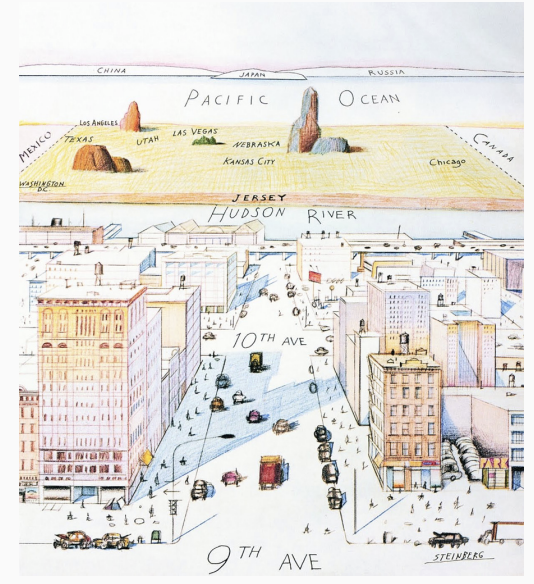
Ethnic Diversity, Public Goods Provision and Social Cohesion
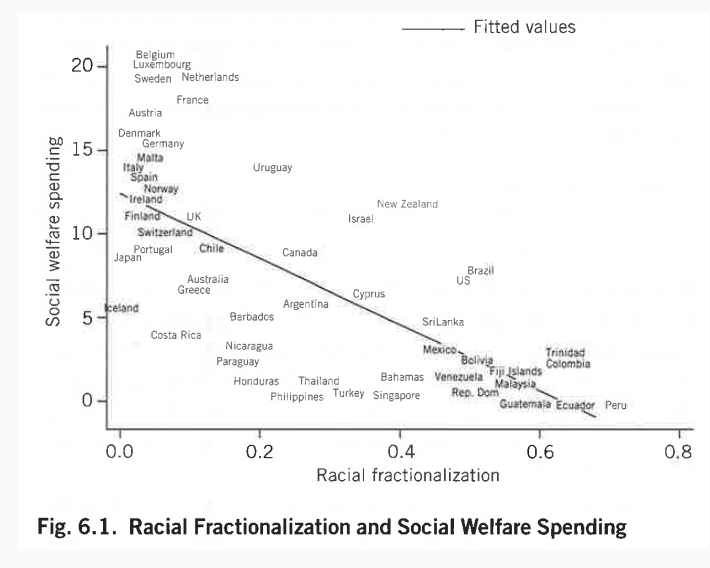
Data
2012 Mapping Local Communities Canada (MLCC)
• Online national survey
• Convenience sample of 7817 (non QC) Canadians Measures of context
• Objective context (% visible minorities in Census DA)
• Boundaries of pseudoenvironments (map-drawing)
• Content of pseudoenvironments (perceptions)
Outcomes Social cohesion & Community Efficacy
Social cohesion
1. People around here are willing to help others in their community.
2. People in this community generally don't get along with each other.
3. People in this community do not share the same values.
Community efficacy
1. If some children were painting graffiti on a local building or house, how likely is it that people in your community would do something about it?
2. Suppose that because of budget cuts the library closest to your home was going to be closed down by the city. How likely is it that community residents would organize to try to do something to keep the library open?
Idea of "conditional cooperation" — people rely on their predictions of how others will behave to decide their own actions
Outcomes Charts

Boundaries of pseudoenvironments
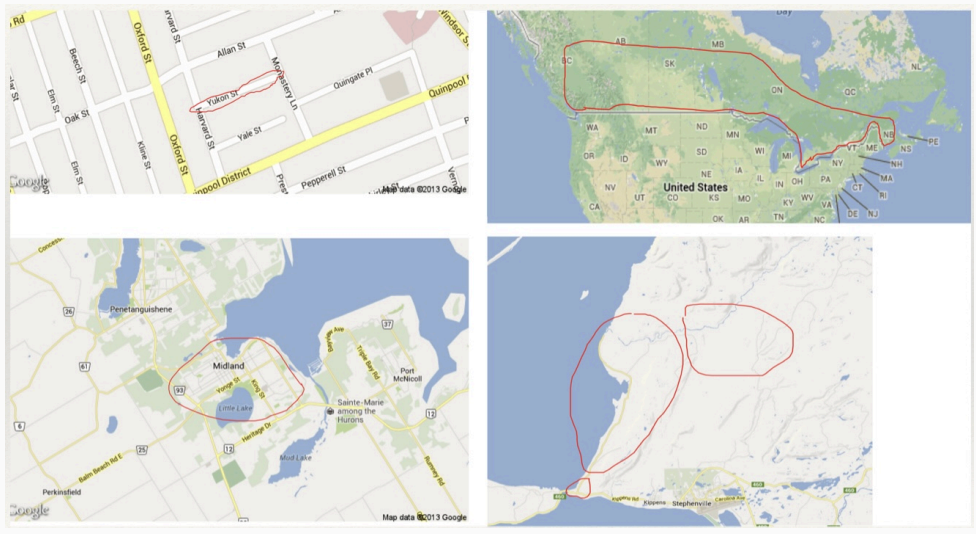
Content of pseudoenvironments

Content of administrative units
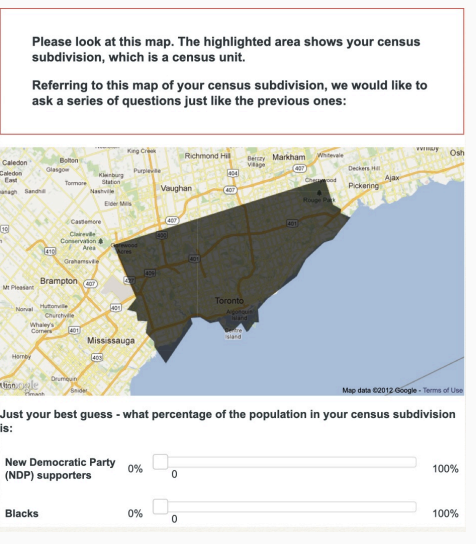
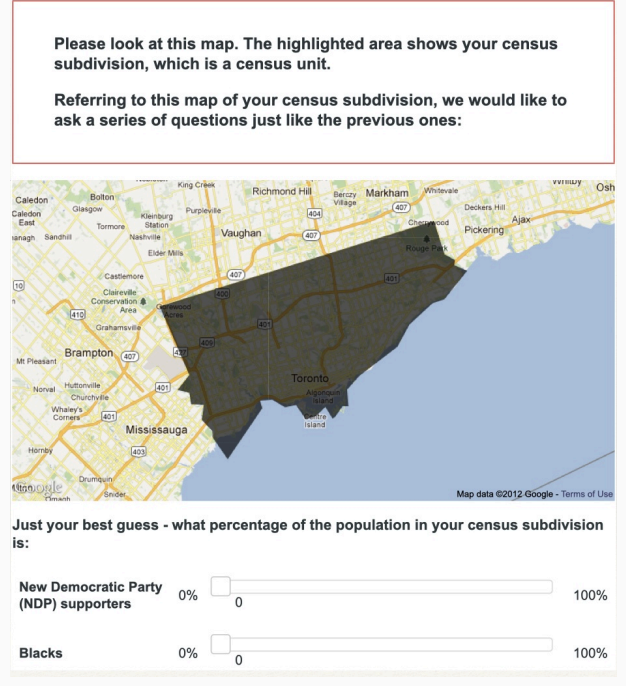
Design
We want to separate the effects of objective and subjective context
To do this, we compare pairs of people who live in very similar (or exactly the same) DA
If a context effect operates by both perceptual and objective pathways, we should see:
• two people who differ in perceptions but not in objective context should express different responses to our social cohesion measures
Findings

Alternative designs
1. Matching on similar DAs, perceiving one's DA (comparing the same objects)
2. Matching on the exact same DA, perceiving one's community (avoid comparing eg Vancouver and Toronto)
3. Matching on the exact same DA, perceiving one's DA (combine 1 & 2)
4. Diversity indices for both matching and perceptions (take account of fractionalization) Don't worry too much about that part, the point is: Similar results, regardless of what design we use!
Is it ethnocentrism? Or maybe SES?
Is it ethnocentrism? Or maybe SES?
• Racists might both perceive more visible minorities living near them & believe their neighbours do not share their values
• In this case, racism is the channel & it's unaffected by objective conditions (since these are constant) or subjective perceptions
• However, that's not the case
• More racist people perceive fewer minorities
• Racism is also related to lower levels of social cohesion and community efficacy
• We can also rule out SES
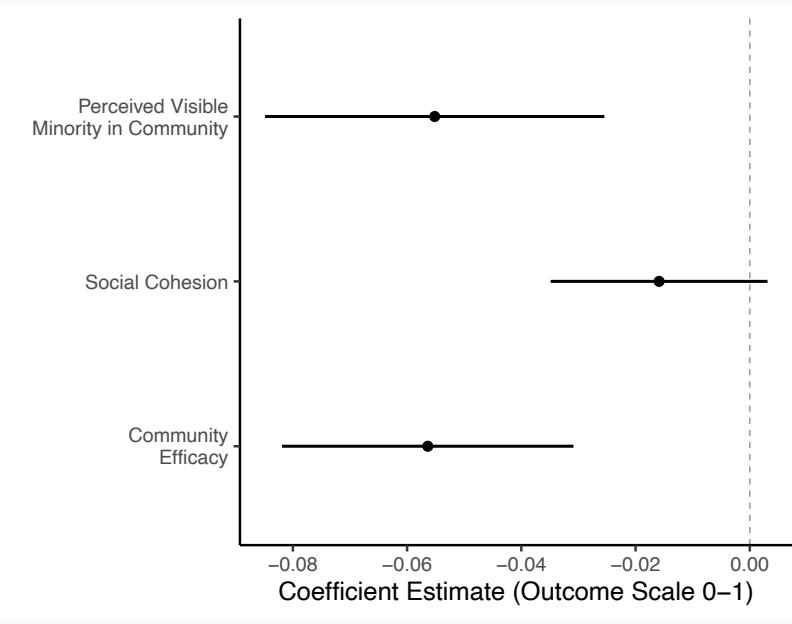
Synthesis and Discussion
• Scale matters: local diversity shows stronger associations with trust than national diversity
• Mechanisms: cooperation shortfalls in diverse settings are about coordination and enforcement, not raw in-group altruism
• Bridging ties: everyday cross-group contact can stabilize trust in diverse neighbourhoods
• Perceptions matter: pseudoenvironments can depress cohesion net of objective context
Perceptions of communities—am I giving you depressing news?
• Conditional cooperation—it seems those who perceive more outgroup members also see less social cohesion & community efficacy
• It could be that outgoup members do have different norms about altruism and prosocialility.But: key is, perceptions of such differences can affect behaviour
• This is not necessarily a bad news story from a policy perspective
• Is it easier to change pseudoenvironments or objective contexts?
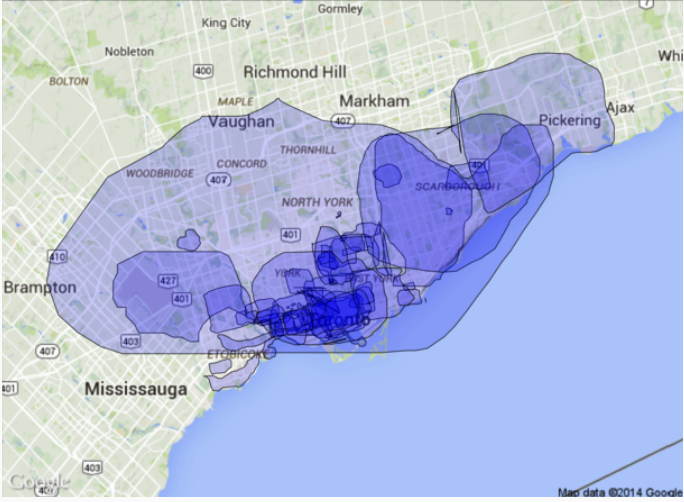
Conclusions
• Two kinds of context effect
1. objective: doesn't require any perception or understanding for an effect (voter ID laws; traffic; lead in the water)
2. "pseudoenvironments": no effect unless it is perceived & evaluated
• We add to the broad literature of this two-path theory by
1. showing that people living in nearly identical objective places can have different pseudoenvironments
2. showing that these pseudoenvironments relate to social cohesion
• ⇑ perceived diversity ⇒ ⇓ social cohesion —even with objective environment held more or less constant
• And we do it with a design that overcomes many of the issues with existing measures of context—since we are measuring context at the individual level